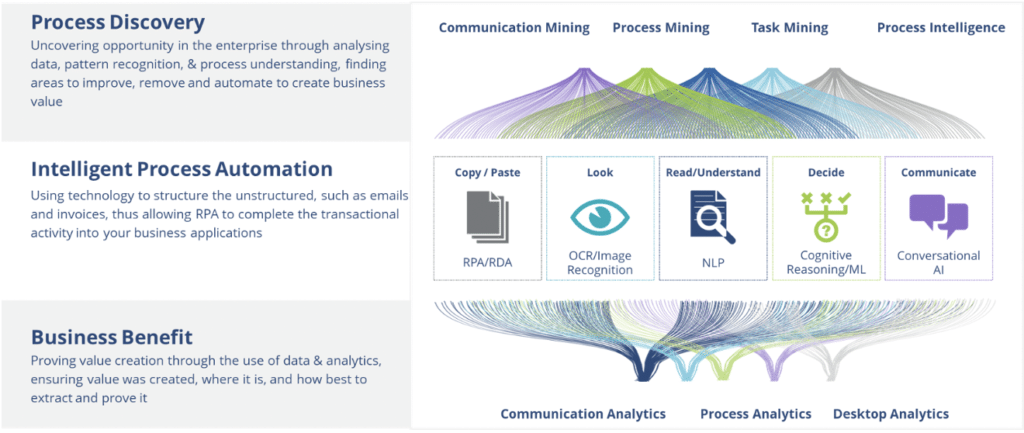
As more organisations go through digital transformation and increase their use of automation, more of them will consider hyperautomation. In fact, Gartner predicts that the market for software that enables hyperautomation will reach $596.6 billion by 2022 (up from $532.4 billion in 2021).
Hyperautomation can bring significant benefits to businesses – making them more productive, agile, cost-efficient and competitive. But organisations need to be prepared for implementation challenges.
Challenge 1: Knowing what hyperautomation is, and what it isn’t
Hyperautomation is a relatively new concept, and as such, there’s often confusion around what it is, exactly. For example, some believe that once an organisation has invested in the widespread use of robotic process automation (RPA), it’s achieved hyperautomation. It hasn’t.
Hyperautomation is not about reaching peak RPA; it is, at least as I describe it, an end-to-end approach to making use of an ecosystem of automation-related technologies. Using it, organisations can identify areas of the business that can be automated, with the process, task, and communication mining tools and then a suite of intelligent automation tools used to deliver automation across key customer journeys and tasks. So, you end up with something like a web of automated solutions which include RPA but also feature artificial intelligence, virtual assistants and things like low-code/no-code application platforms.
ISG’s end-to-end view of hyper automation is seen below.

Once business leaders know what real hyperautomation is, they can start to focus on the challenges of implementation.
Challenge 2: Hyperautomation requires strategic implementation
As hyperautomation is a systematic overhaul of an organisation – making multiple changes to various systems in myriad ways – it must be done strategically to deliver maximum value.
You can automate a single system on a tactical level, but hyperautomation needs a top-down approach. It should come from leaders who can see what sort of automation is needed and wherein the organisation it’s needed, and who can predict how the puzzle pieces will fit together to create the greatest efficiency for the business.
It also takes time to plan and implement – you’re looking at a project that will take years, not months – which is another reason why it requires long-term, strategic vision and senior-level buy-in to be successful.
Challenge 3: Considering the challenges of using multiple technologies
Of course, there are technical challenges to face when you try to make multiple technologies work together, such as automating processes with different structures and shapes while ensuring that you’re still able to create sufficient value to match your increased efficiency after automation.
I’ve often seen people confuse widely used RPA for hyperautomation. In fact, as Gartner states, RPA (aided by AI and machine learning) acts as an hyperautomation enabler – allowing the organisation to automate as many areas of the business as possible.
So, to achieve real hyperautomation, organisations need to focus on their use of RPA, AI and machine learning first.
Challenge 4: Hyperautomation isn’t a magic bullet
While you may have a strategically implemented hyperautomation program in place, you still need the right people and processes for it to be successful. Even the best technology will fail to deliver value in the wrong environment and culture.
Embrace automation. If there’s a process you feel cannot be automated, look at why that’s the case and, if necessary, change the process. Work with experts in emerging technology who understand how to get the most out of automation. If people are reluctant to move forward with automation, investigate why and look for ways to inform people about the benefits that automation can bring the organisation.
Challenge 5: Successful hyperautomation requires change management
The importance of change management is massively underplayed. Many aspects of how the business deals with new change need to be reviewed to create sustainable benefits in the long term.
While it’s crucial that hyperautomation has executive-level advocates (and is overseen by someone at a high level in the company), there’s no guarantee that it will mesh with the existing state of the organisation’s people and processes.
The organisation needs to conduct an impact analysis and then monitor and review how the changes are proceeding so that the program can be adapted as it’s implemented. There are no one-size-fits-all hyperautomation programs. Each organisation must create a hyperautomated environment that works with their specific needs. Sometimes this will mean changing the individual technology you plan to use as part of hyperautomation; other times it will mean adapting existing processes or bringing in people with the skills the company needs to achieve success with hyperautomation.
Organisations that successfully use hyperautomation are fully invested in using emerging technologies to transform their business. They understand that this means a significant change to processes and people and that the organisation may need to shift culturally too. However they embrace these changes, they know that they’re preparing the business to be more agile and resilient – and, ultimately, more successful.



